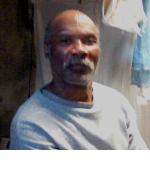Romaine “Chip” Fitzgerald, born and raised in Compton, California, joined the Southern California Chapter of the Black Panther Party in early 1969 as a teenager who had just been released from the California Youth Authority. He was given 2 life sentences for the frame-up of the murder of a security guard and attempted murder of a CHP officer.
Legal Case:
Shoot-Out
On September 7th, 1969, California Highway Patrol pulled over a Volkswagen with Romaine ‘Chip’ Fitzgerald and two other members of the Black Panther Party (Robert Williams and Luxey Irvin). According to the Los Angeles Times, the men were stopped on the corner of Compton Blvd and Van Ness Ave in Gardena, CA for a faulty taillight.
During the traffic stop a shooting broke out, leaving one officer and Chip Fitzgerald injured. The three Black Panthers managed to escape from the scene, leaving the injured officer in possession of Fitzgerald’s driver’s license.
The next day, Chip escaped another shootout with police as he and the others attempted to flee from the house they were held up at. The other two men were arrested during the altercation with one of the men shot in the leg. Fitzgerald, still suffering from a gunshot wound to the head, managed to escape to the Panther headquarters in South-Central Los Angeles. There, Fitzgerald was able to receive treatment, but was informed on by a police informant. Police raided the headquarters only to find a blood-soaked jacket. Chip managed to escape arrest for a third time.
Chip avoided being arrested until October 9th, when he was detained without incident. After being taken custody, he was informed that he was not only charged with the attempted murder of the CHP officer, but was also being charged with the murder of a private security guard, Barge Miller.
Barge Miller
On September 29, 1969 at 1:42 am, Barge Miller a security guard at Vons Shopping Center located at El Segundo and Avalon Boulevards in Los Angeles was shot and robbed while sitting in his car. Two men were seen fleeing from the scene by a witness, James Coleman.
Coleman later identified Romaine Fitzgerald as one of the men fleeing from the scene. While Coleman claims he did not get a good look at the shooter due to the fluorescent lighting of the parking lot, he was sure it was Chip. Despite his confidence, he admitted Chip looked different in court than when he had seen him during the early morning hours of September 29, 1969. He claimed Fitzgerald’s hair was now shorter.
During the investigation, Coleman was shown several photographs of suspects, including one of Romaine Fitzgerald, but he could not identify Chip as the one who committed the crime. Later, he denied ever stating that he couldn’t identify Fitzgerald. However, the only time he was able to identify Chip was in court, sitting at the defendant’s table. During cross-examination, the witness was not even able to describe the judge in the case, when asked to describe him without looking.
According to Chip, because of the gunshot wound to his head, he kept a two-inch wide gauze bandage on the wound for about three or four weeks. He had removed the bandage about three to five days prior to his arrest on October 9, 1969. Coleman stated nothing about a gauze bandage, something that is hard to miss. Chip denied being in the vicinity of the Vons parking lot during the early morning hours of September 29, 1969, and denied participating in any way in the shooting or robbing of Barge Miller. He testified that he never went outside at night before October 9, 1969, because he did not want to infect his head injury.
Chip had witnesses that he was not at the Vons Shopping center during the murder. Doris Haughton and her sister, Janice Sadler shared an apartment with Romaine Fitzgerald and stated that he had not left the apartment on the evening of September 28, 1969.
Despite his witnesses, he was convicted of first-degree murder and was sentenced to death in 1970. Later, the death sentence was commuted to life. Chip was also tried for the attempted murder of the CHP officer. During the trial, the officer admitted that he had orders to shoot members of the Black Panther Party. Despite this admission, the judge in the case ordered the jury to ignore the statement. Chip was subsequently found guilty and was sentenced to life for his involvement in the shootout.
Chip and his supporters, believe the murder of Barge Miller was pinned on him because of his membership in the Black Panther Party and because of his previous altercations with the police. Despite the conviction, he has maintained his innocence in the death of Barge Miller.
Parole
Chip has a good chance of release because of changes in California parole law. Currently, people over the age of 65 who have served 25 years or more are prioritized for release. The seriousness of the original offense is no longer enough to deny parole – “some evidence” of current dangerousness is required. And Chip’s age at the time of his arrest – just 19 – is a factor to be considered at his hearing. Chip has also suffered from a stroke, and has had few incident reports. Chip has been represented in the past by prisoner rights attorney Charles Carbone.
Unfortunately, before he achieved parole, Chip suffered a severe cardiovascular event in March 2021 and passed away in the hospital the following week.
Picture:

